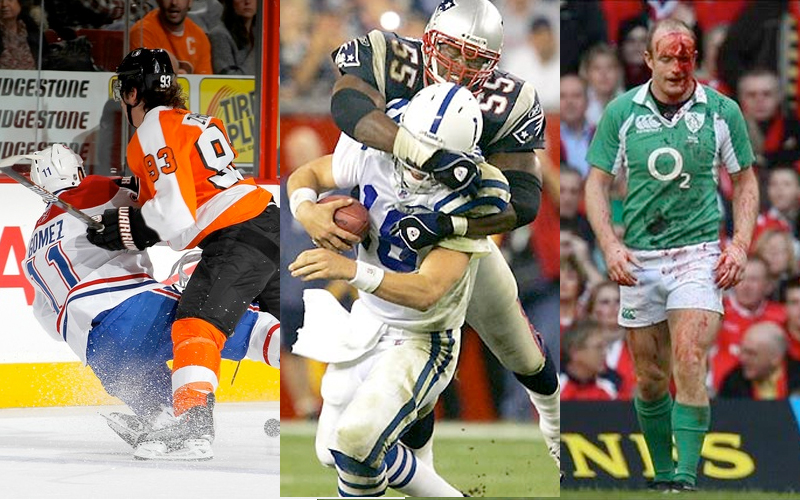Hockey and football are both contact sports. Each has its own risks and dangers.
So, is hockey more dangerous than football? Sports injuries concern many parents, players, and fans. The debate about which sport is more dangerous continues. Hockey involves high-speed collisions on ice. Football has hard tackles on the field. Both sports have their unique risks.
Understanding these risks helps players stay safe. This blog explores the dangers of hockey and football. It aims to provide a clear comparison. Let’s dive into the world of these two popular sports and see which one is riskier for athletes.

Credit: bleacherreport.com
Injury Rates
Understanding the injury rates in hockey and football is vital for players, coaches, and parents. Injuries can affect a player’s career and overall health. Let’s break down the common injuries in these two high-contact sports.
Common Injuries In Hockey
Hockey is known for its high-speed collisions and physical play. Injuries are common due to the nature of the sport.
- Concussions: Players often experience head injuries due to body checks and falls.
- Sprains and Strains: These occur frequently, especially in the lower body.
- Fractures: Bones can break due to falls or being hit by the puck.
- Lacerations: Cuts from skates and sticks are common.
- Shoulder Injuries: These happen from collisions and falls into the boards.
Common Injuries In Football
Football players also face a high risk of injuries due to frequent tackles and physical contact.
- Concussions: Head injuries are prevalent due to hard tackles.
- Knee Injuries: ACL and MCL tears are frequent, often requiring surgery.
- Sprains and Strains: These injuries often affect the lower body, especially the ankles.
- Fractures: Bones can break from tackles or falls.
- Shoulder Injuries: These occur from tackles and falls.
| Injury Type | Hockey | Football |
|---|---|---|
| Concussions | High | High |
| Sprains and Strains | Common | Common |
| Fractures | Frequent | Frequent |
| Lacerations | Common | Rare |
| Knee Injuries | Less Common | Frequent |
Protective Gear
Protective gear plays a crucial role in ensuring player safety in sports. Both hockey and football require players to wear specific equipment. This gear protects them from potential injuries. The type and extent of gear can vary significantly between the two sports. Let’s explore the equipment used in hockey and football.
Hockey Equipment
Hockey players wear helmets with face shields or cages. These protect the head and face from pucks and sticks. Mouthguards are essential for preventing dental injuries. Shoulder pads protect the upper body, including the chest and shoulders. Elbow pads shield the elbows from falls and collisions. Gloves protect the hands and fingers from impacts and cuts.
Players wear padded shorts, known as hockey pants. These protect the thighs, hips, and tailbone. Shin guards cover the lower legs, protecting against pucks and sticks. Lastly, skates provide mobility and include padding to protect the feet and ankles.
Football Equipment
Football players wear helmets with face masks. These protect the head and face during tackles and falls. Mouthguards are crucial for preventing dental injuries. Shoulder pads cover the shoulders and chest, offering protection during tackles.
Players wear padded pants that include thigh, hip, and knee pads. These protect the lower body from impacts. Cleats provide traction on the field, and they often include ankle support. Gloves are worn by some players, especially receivers, to improve grip and protect hands.
Both sports require extensive protective gear. This gear is designed to minimize injuries and keep players safe during the game.
Physical Contact
Physical contact is a major part of both hockey and football. Both sports involve intense physical interactions, but they differ in the types of contact and the rules governing them. Understanding these differences can help assess the risks involved in each sport.
Body Checking In Hockey
Body checking is a key element in hockey. Players use their bodies to block or hit opponents. This physical contact helps gain control of the puck. Body checking can be aggressive and forceful. It often leads to players falling onto the hard ice. Protective gear helps, but injuries can still occur. Concussions and broken bones are common in hockey due to body checking.
Tackling In Football
Tackling is a fundamental part of football. Players must bring opponents to the ground to stop their progress. Tackling involves full-body contact. Football players wear pads and helmets to protect themselves. Despite this, injuries are frequent. Concussions and ligament tears are common in football. The impact of tackles can be severe, causing long-term health issues.

Credit: www.amenclinics.com
Playing Environment
The playing environment has a significant impact on the danger levels of any sport. Both hockey and football have distinct environments that contribute to their overall risk. Understanding these environments helps in comparing the dangers of both sports.
Ice Rinks And Arenas
Hockey is played on an ice rink. The ice surface is hard and slippery. Players wear skates, which can cause severe injuries if not careful.
Ice rinks are enclosed by boards and glass. These barriers can cause injuries during collisions. The cold environment also adds an extra layer of risk.
| Factor | Details |
|---|---|
| Surface | Hard and slippery ice |
| Barriers | Boards and glass |
| Temperature | Cold |
Football Fields And Stadiums
Football is played on grass or artificial turf. The ground is softer than ice, reducing the impact of falls.
Football fields are open with few barriers. There is more space for players to move, reducing the chance of collisions.
Stadiums can vary in size and shape. They generally have more room for players to avoid dangers.
| Factor | Details |
|---|---|
| Surface | Grass or artificial turf |
| Barriers | Few or none |
| Temperature | Varies |
Long-term Health Effects
When discussing the long-term health effects of hockey and football, it’s important to consider the risks each sport poses. Both sports are physically demanding and can lead to serious injuries. This section will explore the long-term health effects associated with hockey and football, focusing on concussions and brain injuries, and chronic conditions.
Concussions And Brain Injuries
Concussions are a significant concern in both hockey and football. These injuries occur due to blows to the head or body, causing the brain to move rapidly within the skull. Concussions can have severe long-term effects, including:
- Memory loss
- Difficulty concentrating
- Emotional instability
- Headaches
In hockey, players often collide at high speeds, increasing the risk of head injuries. Helmets can help, but they do not fully prevent concussions. In football, players frequently tackle each other, which also leads to a high risk of brain injuries. The repeated impacts can cause chronic traumatic encephalopathy (CTE), a degenerative brain condition.
Chronic Conditions
Both hockey and football players are at risk of developing chronic conditions due to the physical demands of the sports. These conditions can affect players long after they retire. Some common chronic conditions include:
- Osteoarthritis
- Chronic pain
- Post-traumatic stress disorder (PTSD)
- Depression
In hockey, the constant physical contact and checking can lead to joint and muscle damage. This damage may result in chronic pain and mobility issues. Football players also face similar risks due to the repetitive tackling and blocking. Over time, these actions can wear down joints and lead to osteoarthritis.
Chronic pain from injuries can also contribute to mental health issues. The emotional toll of dealing with long-term pain may lead to depression and anxiety. Additionally, the stress of competitive sports can cause PTSD in some athletes.

Credit: dish.andrewsullivan.com
Frequently Asked Questions
Is Hockey More Dangerous Than Football?
Hockey is generally considered more dangerous due to high-speed collisions and the use of sticks and pucks.
What Injuries Are Common In Hockey?
Hockey players often suffer from concussions, broken bones, and cuts due to physical contact and equipment.
What Injuries Are Common In Football?
Football players frequently experience concussions, sprains, and fractures from tackles and high-impact plays.
Do Hockey Players Wear More Protective Gear?
Yes, hockey players wear helmets, pads, and mouthguards to protect against injuries from pucks and physical contact.
Do Football Players Have More Head Injuries?
Football players often have more head injuries due to frequent tackles and collisions.
Is Hockey More Physically Demanding Than Football?
Both sports are physically demanding, but hockey requires constant skating, which adds another layer of physical exertion.
Are There More Injuries In Hockey Or Football?
Injuries are common in both sports, but hockey tends to have a higher rate of severe injuries.
How Do Hockey And Football Differ In Terms Of Injury Prevention?
Hockey uses more protective gear, while football focuses on improved tackling techniques and helmet safety.
Which Sport Has A Higher Risk Of Long-term Health Issues?
Both sports carry risks, but football may have a higher risk of long-term brain injuries due to repeated head trauma.
Conclusion
Both hockey and football have risks and require proper safety measures. Understanding the dangers helps players and parents make informed decisions. Each sport has unique hazards, and safety gear plays a crucial role. Ultimately, personal preference and safety awareness should guide your choice.
Stay informed and prioritize safety. Enjoy the sport you love, but always play responsibly.



